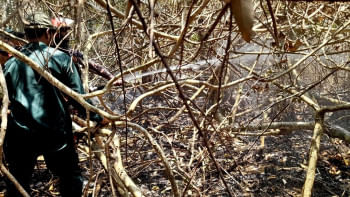Is the last stronghold of Bangladesh’s tigers at risk?

The fire that broke out in Amarbunia, under the Chandpai range in the eastern region of the Sundarbans in Bagerhat on Saturday afternoon (May 4), continued to burn for nearly three days before rain doused it completely. On top of that, several units of the Fire Service, Bangladesh Navy, police, district administration, upazila administration, public representatives, and locals worked to control the fire in the Sundarbans during this time, according to the latest update from the chief conservator of forests.
It harks back to May 3, 2021, when a fire broke out in Bharani under the Sarankhola range, which is not far from Amarbunia. Before that, in 2016, there were four different incidents of fire in the eastern part of the Sundarbans.
This time, the distance of the fire from the nearest water source—almost two kilometres—proved to be a particular challenge, hindering the efforts to extinguish the fire. Along with the Forest Department, the Fire Service, Community Patrolling Groups (CPG), Village Tiger Response Team (VTRT), and members of the navy, air force, police, and coast guard joined the operation, helping to cut off the fire line the next day.
We understand that in the past 22 years, the Sundarbans East Forest Division has faced 32 fire incidents. And every time, the community joined the Forest Department and fought against the fire risking their lives. They are driven by a sentiment, which is Sundarban Mayer Moton (motherly Sundarbans). The Sundarbans protects them from cyclones, gives them food and shelter, and nurtures them the way a mother would.
I had the opportunity to become one of the founders of WildTeam, a national conservation organisation that engages the community through its Village Tiger Response Teams (VTRT), BaghBandhus (friends of tigers), Tiger Scouts, and Forest Tiger Response Teams (FTRT) to protect the Sundarbans and its biodiversity, including the majestic Bengal Tiger. Today we have about 450 such volunteers spread around the 76 villages of the Sundarbans. We believe people are the solution. Under the leadership of the Forest Department, we successfully engaged these volunteers during any natural or anthropogenic crisis in the Sundarbans. Our friends in the Indian part of the forest have replicated our model.
Our slogan is "Save Tigers, Save Sundarbans, Save Bangladesh." Bangabandhu Sheikh Mujibur Rahman, in one of his speeches in 1972, said that were it not for the Sundarbans, we wouldn't be able to protect Bangladesh (he was specifically talking about natural catastrophes, meaning the Sundarbans acts as a shield—as we saw during a number of cyclones in recent times). Tigers are the natural guards of the Sundarbans. Thus, they are the guardians of the Sundarbans.
The increased disturbance of the forest cover caused by fires such as the one this week will force the wildlife to leave the forest in search of food inside the villages, which will enhance the chances of human-wildlife conflict.
We used to have tigers in almost all the forests in Bangladesh. Today, Sundarbans is the last stronghold of Bangladesh's remaining tigers. According to the last tiger survey in 2018, Bangladesh has 114 tigers. However, we feel concerned about the fact that three tigers have reportedly died in the last five months.
On November 25, 2023, the Forest Department recovered a tiger's carcass from the Kachikata area adjacent to the Raimangal River in Satkhira range. On February 12, 2024, a dead tiger was spotted in the Kachikhali area of the Sarankhola range located under the Sundarbans East Forest Division. On April 30, 2024, the forest guards recovered a floating carcass of a tiger from the Karamjal area in the Sundarbans east.
The Forest Department is the custodian of the country's forests and wildlife. They are forced to work with huge limitations in the Sundarbans. We need to focus on these foresters by increasing their capacity and facilities—the sooner the better. At the same time, we need to engage the community as well and build up their social capital, before we lose our national pride: the Sundarbans and the Bengal Tiger.
Then again, on April 20, 2024, we lost one of the honey collectors in the Sundarbans. He was attacked by a tiger at Notabeki under Satkhira range. The tiger attacked Maniruzzaman and tried to drag him into the deep forest. His fellow honey collector rescued him from the clutches of the tiger, but he died soon after. Maniruzzaman was a resident of Gabura, where most of the "tiger widows"—whose husbands died in tiger attacks—live. He, too, left behind two wives.
Most of the breadwinners living around the Sundarbans largely depend on the forest resources. Infertile and inhabitable land, habitat loss, dense population and climate change make the situation complex. Researchers predict that due to climate change and sea level rise, there will be no remaining tiger habitats in the Sundarbans by 2070. About 3.5 million people live on the fringes of the Sundarbans, where fishing, honey and wood collection are their mainstays for living.
More than 40 percent of the people are on the edge of poverty. Salinity, siltation, and climate emergencies make people's lives much harder. Poison fishing, unsustainable fishing, and many other anthropogenic threats are on the rise. These days, the fish catch has gone down, which forces the community to venture inside the forest, making them easy prey to tigers.
The Forest Department is the custodian of the country's forests and wildlife. They are forced to work with huge limitations in the Sundarbans. We need to focus on these foresters by increasing their capacity and facilities—the sooner the better. At the same time, we need to engage the community as well and build up their social capital, before we lose our national pride: the Sundarbans and the Bengal Tiger.
Enayetullah Khan is founder of WildTeam and editor-in-chief of the United News of Bangladesh (UNB) and Dhaka Courier.
Views expressed in this article are the author's own.
Follow The Daily Star Opinion on Facebook for the latest opinions, commentaries and analyses by experts and professionals. To contribute your article or letter to The Daily Star Opinion, see our guidelines for submission.

 For all latest news, follow The Daily Star's Google News channel.
For all latest news, follow The Daily Star's Google News channel. 








Comments